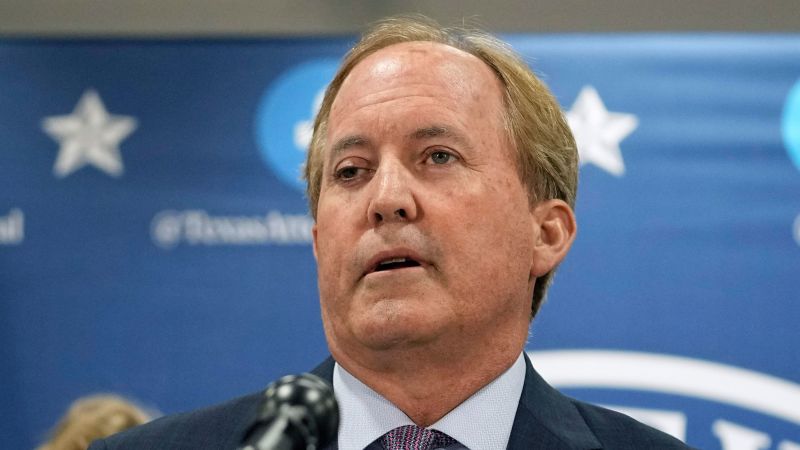The impeachment trial of Ken Paxton, the Texas attorney general who faces accusations of repeatedly abusing his office to help a donor, is set to begin Tuesday in the state Senate.
Paxton, a firebrand conservative Republican who has aligned himself with former President Donald Trump and played a central role in steering the state rightward in recent years, has been suspended from his duties since the GOP-led House impeached him in May.
Since taking office in 2015, Paxton has been beset by a series of scandals. He remains under indictment on securities fraud charges and faces an additional federal investigation after former staffers accused him of accepting bribes and abusing his office.
It was his request for $3.3 million in state funds for a settlement with those whistleblowers that prompted the state House GOP to impeach Paxton on a 121-23 vote, with two members voting “present.”
The Republican-controlled state Senate, though, is friendlier ground for the embattled attorney general. He has a number of conservative allies there – including Lt. Gov. Dan Patrick, who will preside over the trial. His wife, Angela Paxton, is a member of the Senate, though she has been barred from voting at the trial.
Here’s a look at who Paxton is, why he was impeached and how his trial will unfold:
Paxton is a longtime fixture in Texas politics, serving in the state House and Senate before his election as attorney general in 2014, and then reelection in 2018 and 2022.
Until his impeachment, he was best known for challenging Barack Obama’s executive orders and legislative achievements in court – including battles against Obamacare and the former president’s immigration orders.
In an effort to overturn the results of the 2020 election, he asked the US Supreme Court to invalidate the Electoral College votes of four swing states won by Joe Biden. The lawsuit was dismissed. Paxton then traveled to Washington to attend the “Stop the Steal” rally on January 6, 2021, where the attorney general told the crowd, which included people who would soon riot at the Capitol, “We will not quit fighting.”
Paxton has faced scandal for years. He was indicted by a grand jury in 2015 on securities fraud charges following allegations that he misled investors about his financial ties to a technology company while selling shares of that company. That case has still not gone to trial and has been delayed by years of disputes over where the trial should take place.
In 2020, top Paxton aides published a letter accusing the attorney general of abuse of office, bribery and improper influence – complaints centered on Paxton’s ties to donor and friend Nate Paul.
Four of the former staffers later sued the attorney general’s office, claiming they were fired in violation of the state’s whistleblower law. In February, Paxton agreed to a settlement in which he did not admit fault and the whistleblowers would be paid $3.3 million. He asked state lawmakers to fund that settlement.
The House impeachment managers have already submitted nearly 4,000 pages of evidence, unveiling more details in the extraordinary accusations that Paxton pressured his top aides to take steps that would benefit Paul, a real estate investor.
Paxton is accused of accepting $20,000 in countertop materials from Paul through a contractor during a remodeling of his home.
Also included in the allegations is that Paxton had a mistress, whom Paul hired as a favor to the attorney general, and that Paxton would use an alias – “Dave P” – on Uber to meet up with the mistress, as well as Paul.
Paul was arrested in June on eight federal felony charges related to falsifying financial records, and his lawyer has repeatedly declined comment to CNN.
The Texas Senate’s impeachment trial begins Tuesday and is expected to last two or three weeks. Patrick, the lieutenant governor and a Paxton ally, will preside, serving in a judge-like role.
Tuesday morning, the Senate clerk will read the state House’s 20 articles of impeachment one by one and ask Paxton or his lawyer to plead on each. Paxton can either appear in person or by counsel. He can plead guilty or not guilty.
After the reading of the articles and Paxton’s pleas, the House impeachment managers and their legal team will have 60 minutes to make their opening statement, followed by Paxton’s team, also with 60 minutes.
Then the House managers will start presenting their case. Each side gets 24 hours to present evidence and witnesses, which could stretch out over days. Paxton’s lawyers have said the attorney general will not testify, though it’s possible House managers could compel him to take the stand via subpoena.
Each side will also get 60 minutes for closing arguments. Paxton’s side will close first, followed by the House impeachment managers.
At the end, senators will deliberate behind closed doors and will submit a written vote for each article.
A conviction requires 21 of the 30 eligible state senators to vote against Paxton. Assuming all 12 Democrats vote to convict him, nine of the 18 voting Republicans would also have to convict Paxton.
There are 31 members of the Senate. However, Paxton’s state senator wife, Angela, will not be allowed to vote or sit in on the closed-door deliberations. She has, however, been permitted to sit in as a member of the court.
Initially, Angela Paxton said she would not recuse herself, but the new Senate rules then banned her from voting. Allowing her to sit in on the trial, however, essentially helps her husband because the conviction threshold is 21, rather than 20 had she been removed altogether from the trial.
At any point, a majority of the Senate could vote to dismiss the charges, which would end the proceedings.
If the Senate votes to convict Paxton, he would be removed from office. But the Senate would have to hold another vote to permanently bar him from holding office.
That’s what happened in 1917, when Texas Gov. James “Pa” Ferguson was removed from office on embezzlement charges and barred from holding future office. His wife, Miriam “Ma” Ferguson, ran for governor in 1924, under the pledge that Texas would get “get two governors for the price of one.” She won – becoming the state’s first female governor – but lost in a primary two years later. She won a second two-year term in 1932.
Paxton has described his impeachment as a “politically motivated sham” and has consistently denied wrongdoing.
The Texas Tribune reported that at a Collin County GOP picnic Saturday, Paxton criticized Texas House GOP leadership.
“Let’s clean house,” he said.
Paxton has long aligned himself with the most conservative, hard-line forces in the GOP – and many of those forces have backed him. Trump has supported him, lambasting the Republicans who impeached him as “RINOS,” or Republicans in name only, and calling his impeachment “election interference.”
Read the full article here




